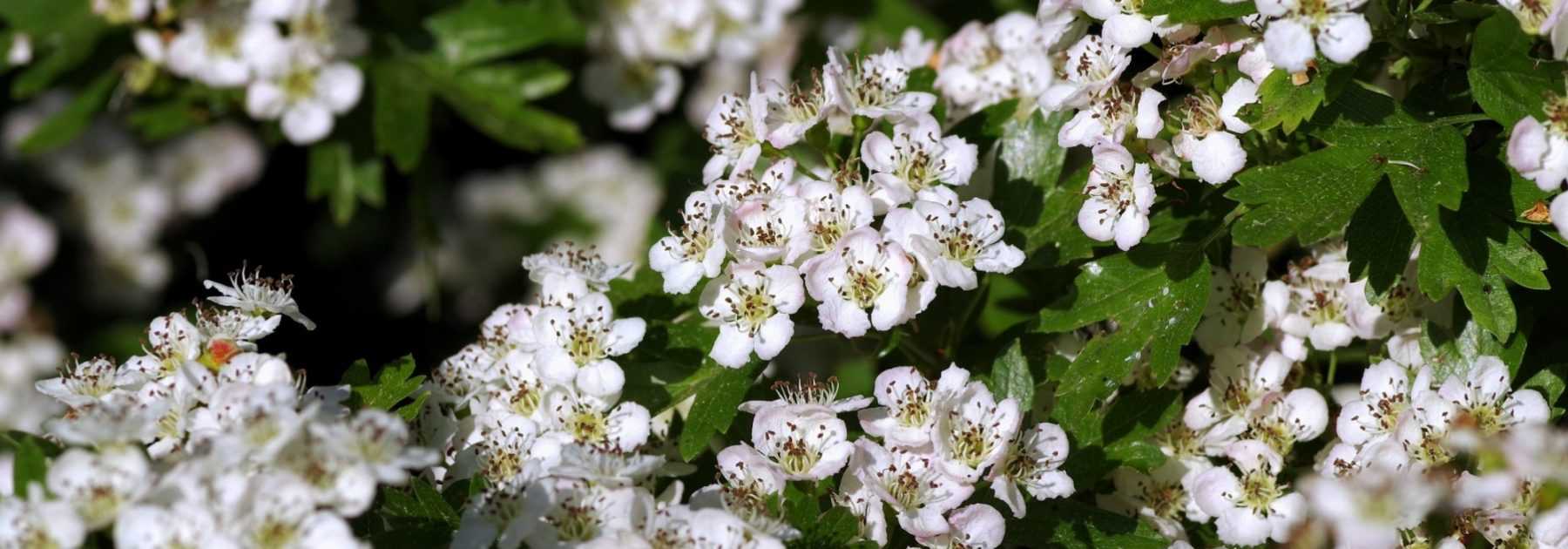
Hawthorn, Crataegus: planting, pruning and care
Contents
The hawthorn in a few words
- The hawthorn is a very hardy and resilient small tree or large bush that adapts to most soils or situations.
- They flower in May and produce edible fruits in September.
- In the garden, they can be used as a pruned hedge, a free-growing hedge or as a standalone ornamental small tree.
- True oases of wildlife, hawthorns provide shelter and food for insects, birds and small mammals.
- There are many varieties including some with double flowers, which are highly decorative.
Our expert's word
The hawthorn or rather the hawthorns – as there are very many species – of the genus Crataegus are small trees or large deciduous bushes that are particularly hardy. Our two native species are called Crataegus laevigata and Crataegus monogyna. These are also the two main species found in commerce.
Although they do not particularly thrive in dense shade, they adapt to all other situations and all types of soil, even the most clayey. Add to this their exceptional hardiness, and hawthorns are among the easiest flowering small trees to grow successfully in the garden.
Their fragrant white or pink flowering in May is a delight for bees. Meanwhile, their haws, the small fruits, are a treat for birds and small mammals. The tangle of thorny shoots provides a safe shelter for all garden wildlife.
It is also a medicinal plant known since antiquity, with numerous legends and local stories found in literature and collective imagination.
In a natural garden, within a slightly wild or defensive free hedge, or simply as a charming small ornamental tree in a shrub border alongside other flowering bushes (ornamental apple tree, beauty bush or black elderberry): the hawthorn is clearly a must-have to (re)plant in our gardens! So consider leaving it a little space…
Description and Botany of Hawthorn - Crataegus
Botanical data
- Latin name Crataegus spp.
- Family Rosaceae
- Common name Hawthorn, Maythorn, May tree
- Flowering May-June
- Height 2 m to 8 m
- Exposure sun or partial shade
- Soil type ordinary, even poor, calcareous or clay
- Hardiness -15°C
Native to the entire Northern Hemisphere (North America, Asia, Europe and even North Africa), hawthorns belong to the rose family. The genus Crataegus includes over a hundred different species, not counting hybrids and subspecies. Here are some examples you might encounter at nurseries: Crataegus azarolus, Crataegus brachyacantha, Crataegus chrysocarpa, Crataegus coccinea, Crataegus cuneata, Crataegus crus-galli (known as “cockspur thorn”), Crataegus douglasii, Crataegus flava, Crataegus lavaleii, Crataegus mollis, Crataegus phaenopyrum, Crataegus pinnatifida, Crataegus wattiana, … But it’s mainly our two native hawthorns that you’ll most commonly encounter: Crataegus monogyna and Crataegus laevigata.
They are all small trees or bushy shrubs with deciduous foliage growing on a single trunk. In European species, the alternate leaves are deeply lobed, with 3 to 9 lobes, while in American and Asian species, the leaves are single and ovate. The grey bark is channelled and rough.
They are also thorny and highly ramified shrubs, ideal for defensive hedges and for protecting birds during nesting season and small mammals throughout the year.
The white, pink or red flowers, depending on the species or cultivar, with five petals bloom in May and are grouped in corymbs. The stamens are red. These flowers are fragrant and very melliferous. Depending on the cultivar, the flowers can be single, semi-double or double (as with ‘Paul’s Scarlet’ for example).
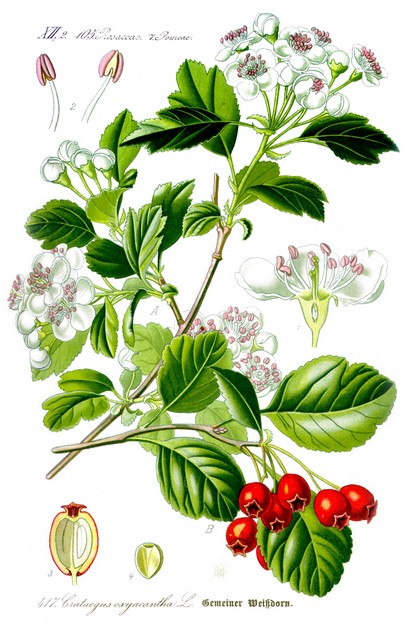
Crataegus laevigata – botanical illustration
This is followed in September by red, yellow or blue fruiting that is edible for animals and gardeners. Although somewhat bland in flavour, the haws are enjoyable in jam with other fruits (see ‘recipe’ section below).
Carl von Linné did not distinguish between our two native hawthorns: Crataegus monogyna or Common Hawthorn, found throughout France and Belgium, and Crataegus laevigata or Midland Hawthorn, found mainly in southern France to North Africa, and grouped them simply under the name Crataegus oxyacantha from the Latin ‘Oxus’ meaning ‘acute’ and ‘Acantha’ meaning ‘thorn’. It’s true that at a simple glance at the leaves, these two hawthorns are practically impossible to tell apart (there are even hybridisations between the two). The two species are quite different when it comes to their flowers, with one style for C. monogyna and two styles for C. laevigata, and their haws, a drupe (fruit with a single large pip) in C. monogyna and a berry (fruit with many small seeds) in C. laevigata. So don’t be surprised to find the name C. oxyacantha in older works.
Sexual maturity, and thus the first flowers, occurs around 5 or 6 years of cultivation. With fairly slow growth, its longevity can extend to over five hundred years. Nowadays, it’s not uncommon to encounter very old hawthorns in European villages. Since antiquity, hawthorn has been venerated and used for its fruits, flowers and leaves for medicinal purposes, particularly as a cardiac regulator and for lowering blood pressure. And many beliefs, legends or local stories about it haunt literature and collective imagination.
They are used in the garden as a formal pruned hedge or a free-growing hedge: both becoming practically impenetrable over the years. But they can also be planted as specimens or among other shrubs within a border.
Hawthorns are very hardy and resilient small trees that grow in sun or partial shade and adapt to any soil: poor, stony or even clay.
Our favourite hawthorn varieties
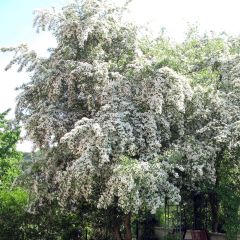
Crataegus monogyna - Hawthorn
- Flowering time May to July
- Height at maturity 7 m
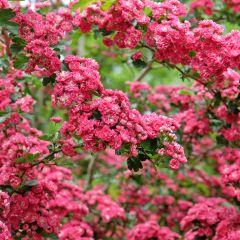
Crataegus laevigata Pauls Scarlet - Hawthorn
- Flowering time May to July
- Height at maturity 6 m
Discover other Hawthorn Crataegus
View all →Available in 1 sizes
Available in 1 sizes
Available in 3 sizes
Available in 1 sizes
Available in 1 sizes
Available in 1 sizes
Available in 1 sizes
Available in 1 sizes
Available in 1 sizes
Available in 1 sizes
How to plant hawthorn?
Planting a hawthorn with naked roots
To plant a hawthorn with naked roots:
- Prepare the roots: cut off dead ones and shorten any that are too long
- Dip the roots in a slurry: a mixture made of manure, soil and water
- Dig a trench or several holes large enough to allow the roots to spread
- Place the bushes and refill the holes with the excavated soil
- Water to avoid any air pockets
- Gently firm the soil around the base of the young bushes and mulch
Planting a hawthorn in a bucket or pot
- Soak your buckets or containers in water for an hour to moisten the root ball
- Dig holes twice the size of the root ball
- Remove the bushes from their containers and carefully loosen the root ball
- Add some well-rotted compost to the bottom of the hole
- Place the bushes and refill the holes with the excavated soil
- Water thoroughly to prevent air pockets between the soil and roots
- Firm the soil around the base of the bushes and mulch
Planting hawthorn for a defensive hedge
Plant your hawthorns in two staggered ranks, spaced thirty centimetres apart. Cut the trunk of your young hawthorns to about 40 cm in height to encourage good ramification from the start.
How to propagate hawthorn?
Propagating Hawthorn by Sowing
This is the simplest and most effective method. In fact, birds often do the work for you. It’s not uncommon to find young shoots of hawthorn scattered randomly around the garden. However, if you wish to carry out the sowing yourself, you’ll need to be patient for at least the entire winter. Indeed, the seed requires stratification to germinate.
You can sow hawthorn seeds:
- either directly in situ: for this, dig a small hole in the ground in autumn, place one or several haws inside and cover. By the following spring, you’ll see the first leaves of a young hawthorn emerging.
- or in pots: to do this, in autumn, soak your haws in lukewarm water for 48 hours. Then place them, once softened, in a watertight container filled with sand. Keep this container throughout winter at around 10°C. At the beginning of spring, plant in pots using a mixture composed of one-third garden soil, one-third compost and one-third sand. Alternatively, you can place the haws in the freezer for a week before sowing in pots to be kept outside until spring.
Propagating Hawthorn by Grafting
If you wish to reproduce a specific variety, you can proceed with shield budding. This isn’t complicated but usually produces an unsightly swelling at the graft point. Take a single hawthorn (such as C. monogyna or C. laevigata) which will serve as the rootstock, make a slight T-shaped incision in the bark at the base of the trunk. Gently pry open the bark, then insert an eye from the variety you wish to propagate (the scion). This eye or bud is taken from the axil of a leaf or shoot. Secure everything in place with a raffia tie.
→ Learn more with our tutorial How to Easily Propagate Hawthorn?
How to care for, prune and look after hawthorn?
Hawthorn Care
Hawthorns require very little maintenance. Just remember to water them during the first year after planting, especially during summer droughts.
Hawthorn Pruning
Hawthorns tolerate pruning particularly well, which is why they are commonly found in many tightly trimmed hedges.
Annual pruning of a formal hedge should always be done after flowering, around late June or early July. You will lose that year’s berries, but this won’t affect the following year’s flowering. Hawthorns can be pruned very short. When young, don’t hesitate to prune severely right after planting to encourage branching.
To train a hawthorn into a tree, remove lower lateral branches and any suckers, gradually raising the crown over the years to maintain a single trunk.
Finally, note that in a natural hedge or wild garden setting, you can simply leave your hawthorn to grow freely without pruning.
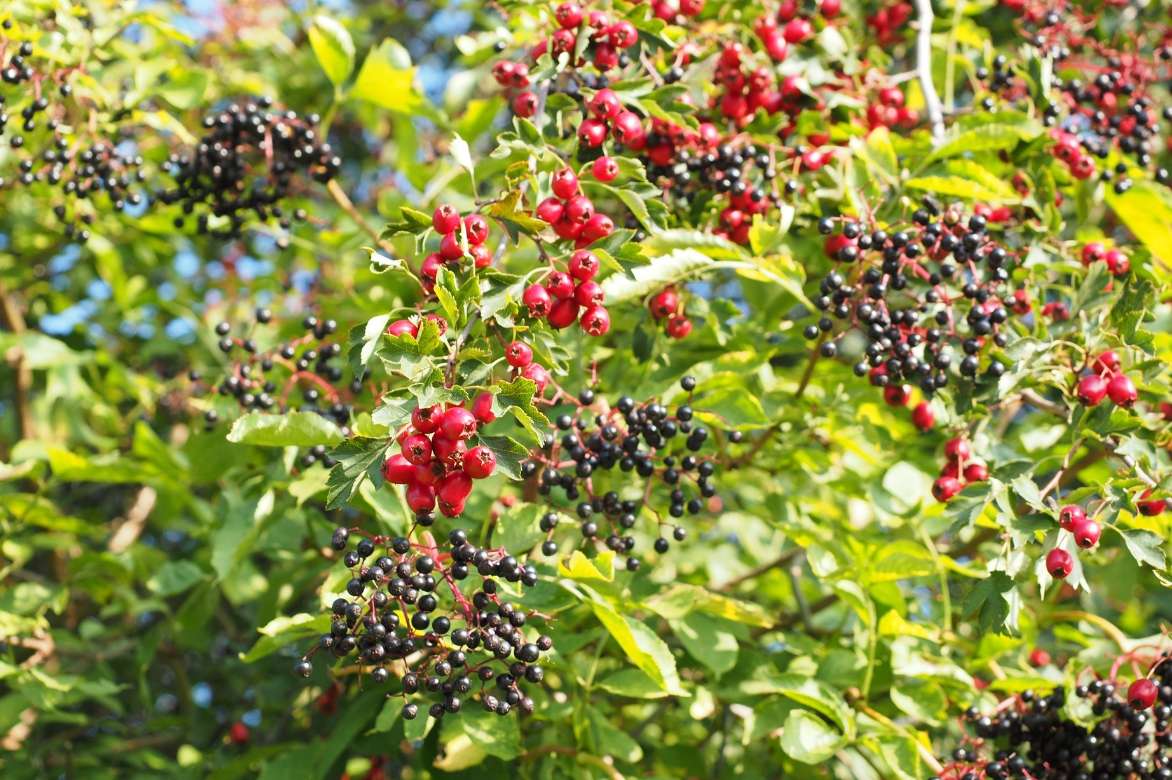
Red hawthorn berries accompanied by black elderberries
Potential Hawthorn Diseases and Pests
Hawthorns are resilient small trees, though they may occasionally experience minor issues, usually cosmetic and rarely dangerous to the tree.
- Entomosporium Leaf Spot
This fungal disease affects some Rosaceae family trees during humid periods. While not fatal, it causes unsightly grey spots on leaves. Remove affected leaves and cut back dead or dry shoots.
- Powdery Mildew
Powdery mildew or “white mould” is another fungal disease affecting nearly all plants. A light white coating appears on leaves. Don’t worry – it’s not serious for hawthorns. To prevent it, space your trees and bushes adequately and avoid wetting foliage during hot weather.
→ Learn more about this disease in our advice sheet: “Powdery Mildew or White Mould”
- Rust
Rust appears in warm, humid weather, identifiable by large rust-coloured spots on leaves that hinder photosynthesis and weaken the tree slightly. Remove affected leaves. Treatments with nettle or horsetail manure are usually effective.
- Fire Blight
There was a time when the mere mention of “fire blight” struck terror into nursery owners and fruit producers. This highly contagious bacterial disease mainly attacks Rosaceae family plants in warm, humid conditions: apples, pears, quince, cotoneaster, pyracantha, rowan and… hawthorn. Symptoms are very visible: black or rust spots appear on some leaves, entire shoots suddenly blacken and dry out, flowers and fruits turn brown-black and remain attached to the tree as if… burnt. The tree may die within a year.
No treatment is effective. You’ll need to cut and burn all infected material several centimetres below the infection, disinfecting tools with alcohol afterwards. Sometimes complete removal of the tree or entire hedge may be necessary.
Fortunately, this disease is now largely a distant memory. Modern cultivated varieties are resistant (or grafted onto resistant rootstocks). Susceptible varieties have been withdrawn from sale (e.g. the ‘Passe-crassane’ pear in France). But vigilance remains essential…
→ Learn more about this disease in our advice sheet: “Fire Blight: Identifying and Combating This Disease”
- Gall-forming Aphids and Other Cecidogenous Insects
Sometimes you may notice “strange” things on hawthorns: leaves suddenly growing in rosettes at shoot tips, curling leaves, or small pustules on leaf undersides. Don’t worry – it’s not a disease! It’s simply the tree’s reaction to an insect or mite laying eggs, causing a gall or cecidium that’s harmless to your hawthorn.
Several insects and mites, particularly tiny dipterans (gall midges), aphids (woolly aphids) and eriophyid mites use hawthorns as their sole host plants (or nurseries, one might say). Since hawthorns aren’t at risk, there’s no need to spray insecticides (even organic ones!). Moreover, galls are such resistant cocoons that spraying would be pointless, only killing surrounding organisms. Let this little ecosystem live in peace and take interest in the fascinating science of gall study: cecidology.
Please note: “gall-forming” and “cecidogenous” are synonyms, both simply meaning “produces galls”.
→ Learn more about hawthorn diseases and pests in our advice sheet
How to pair and use hawthorn? (Note: The translation uses "hawthorn" as the standard British English term for "aubépine". The glossary terms "thorn" for "épine" and "spike" for "épi" were not applicable in this short phrase as they don't appear as isolated words.)
Combining Hawthorns in a Pruned Defensive Hedge
What better way to protect your privacy and peace than with a hedge that pricks, scratches, bruises and scrapes! If you plant white thorns, flanked by Pyracantha, Holly and Berberis julianae, and take care to prune your hedge regularly to densify it, not even a cat will manage to get through. Plus, it will look beautiful all year round thanks to the evergreen foliage of some, the many colourful fruits in autumn, and the magnificent white flowering of the hawthorn in May.


An example of a defensive hedge combination: Crataegus monogyna, Ilex aquifolium, Pyracantha ‘Orange Glow’ and Berberis julianae
Combining Hawthorns in a Free-Growing Ecological Hedge
If you want to combine the beauty of a slightly wild flowering hedge with helping nature, the hawthorn is clearly a must. As are blackthorns, Guelder Rose, Black Elder, Common Dogwood and hazelnut trees. Leave these bushes free from systematic pruning. They will provide shelter and food for all the wildlife in your garden while being very beautiful all year round with their flowering, fruiting, autumn foliage and colourful winter twigs.


An example of an ecological hedge combination: Crataegus monogyna, Prunus spinosa, Sambucus nigra and Viburnum opulus
Combining Hawthorns in a Shrub Bed
Fancy a pretty little bed of spring-flowering shrubs? Try Crataegus laevigata ‘Paul’s Scarlet’, which will flower in May with an explosion of double dark pink flowers alongside a Beauty Bush and an Prague Viburnum with evergreen foliage. To extend these flowerings into midsummer, pair them with a Deutzia with pink and white flowers and a Buddleia alternifolia with melliferous pink-lilac flowers. This little bed, so vibrant in spring and early summer, might look a bit dull in winter unless you add a small Blue Spruce, which will accompany your shrubs with its beautiful blue needles all year round. For ground cover, try a “tapetum” of Cornus sericea ‘Kelseyi’, a decorative wood cornus that grows no taller than 75 cm and will delight you with its charming autumn foliage and colourful winter twigs.
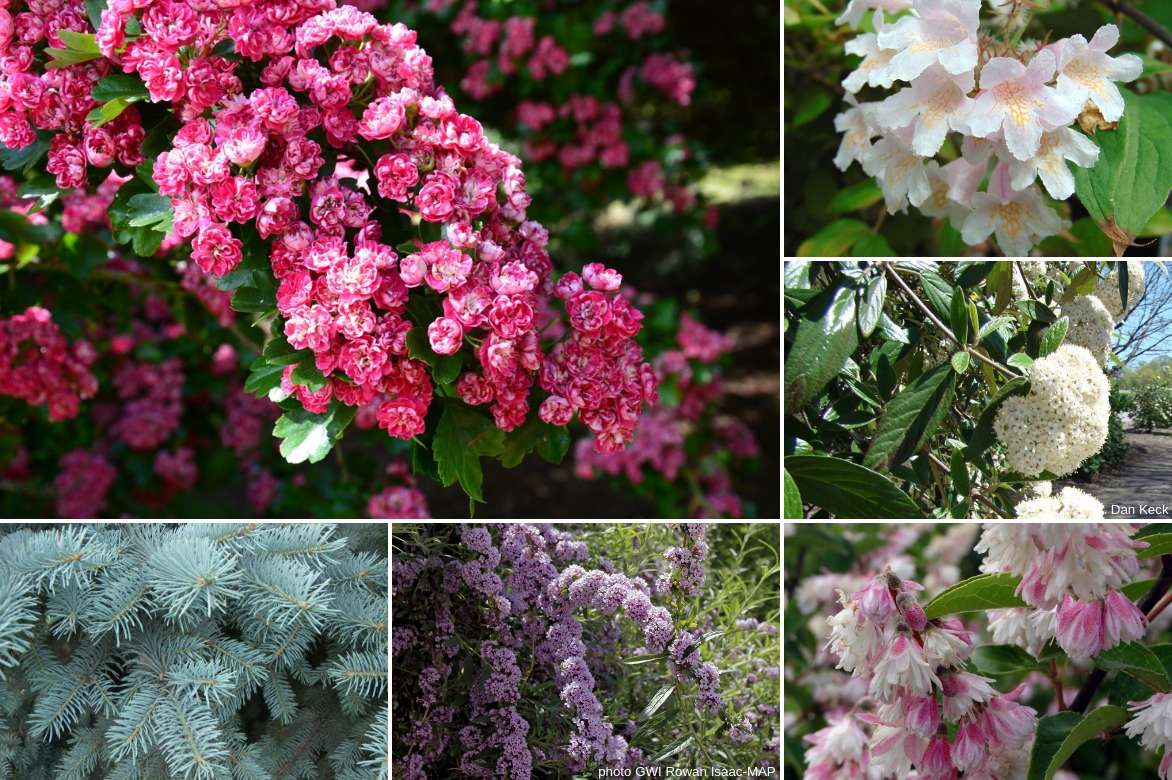

An idea for a shrub bed combination: Crataegus laevigata ‘Paul’s Scarlet’, Kolkwitzia amabilis, Viburnum pragense, Deutzia scabra ‘Plena’, Buddleia alternifolia and Picea pungens ‘Glauca Globosa’
Please note: hawthorns make cute little bonsai trees ideal for beginners. These small trees quickly develop mature bark, tolerate repeated pruning well and branch out nicely. Plus, the “miniature” size of their flowers and fruits makes them look very natural as bonsai.
→ More ideas for combinations with hawthorn in our guide: How to combine hawthorns
Useless Trivia About Hawthorns
- In the past, logs were made from hawthorn wood
- The hard wood of hawthorn was used to make barrels or small mechanical parts
- Marseille fishermen used to place a hawthorn branch at the top of the boat’s mast, which brought them the luck of a miraculous catch
- Hawthorns symbolise fidelity, chastity and celibacy
- Countless legends surround these small trees, which are said to repel lightning, snakes and sorcerers. (I have many hawthorns at home and very few sorcerers knock on my door. You see, it works!)
- The director of the DeLorean car factory decided, against his workers’ advice, to uproot a centuries-old hawthorn tree, reputed to be home to fairies. He went bankrupt the following year… (well, truth be told, it was mainly due to poor management and ugly, poorly designed cars… But it’s a nice story)
“Hawthorn, my dear,
I pick you and take you.
If I die along the way,
Serve me as sacrament. “
Hawthorn berry jam recipe
Recipe for Hawthorn and Raspberry Jam
- Remove the seeds from 2 kg of Craetegus monogyna haws using a fork (this species has only one large seed, making it easier);
- Cook them in a little water until they can be mashed with a fork;
- Strain through a sieve, then add the raspberries (about 500 g);
- Weigh the mixture and add 3 parts sugar to 4 parts fruit (e.g., for 2 kg of fruit, use only 1.5 kg of sugar);
- Cook over high heat for about 15 minutes, stirring constantly with a wooden spoon;
- Occasionally, drop a little onto a cold saucer to check if the jam sets;
- As soon as it does, turn off the heat and pour into sterilised jam jars (with a closed system);
- Seal them, turn them upside down, and let them cool.
Useful resources
Discover our hawthorns at the nursery.
Our advice sheets:
- How to combine hawthorns?
- Choosing the right hawthorn for your garden
- Essential white-flowered hawthorns for your garden
- Discover pink and red-flowered hawthorns
- When and how to plant a hawthorn hedge?
- How to prune a hawthorn?
- and our tutorial: How to make hawthorn tea?
Frequently asked questions
-
Should we still fear fire blight? (Note: While "bactérie" is translated as "bacterium" per the glossary, "feu bactérien" is a fixed phytopathological term in English as "fire blight" (caused by the bacterium *Erwinia amylovora*). The glossary term applies to the standalone word "bactérie" but not to this specific plant disease name.)
Let's say you need to be cautious and attentive to the slightest symptoms. But nowadays, this disease is much less prevalent in our gardens and crops. The reason is that susceptible varieties have been uprooted and permanently removed from sale, leaving room only for resistant varieties.
-
On my hawthorns, there are leaves forming rosettes at the ends of the branches. What is this disease?
This is not a disease but a reaction of your hawthorns following the sting of a tiny dipteran called Dasineura crataegi: this is known as a gall or cecidium. It frequently occurs in pruned hawthorn hedges. Although this phenomenon is striking, it is completely harmless to your bushes and there is no need to worry about it.
-
I received a small hawthorn bush but I would like it to grow into a tree. How can I do this?
Examine your tree to determine the strongest stem of your bush and prune the other branches as soon as you plant it. Later, when your standard tree has grown, you can prune a few low lateral branches to slightly raise the crown. Also remove all shoots at the base.
- Subscribe!
- Contents
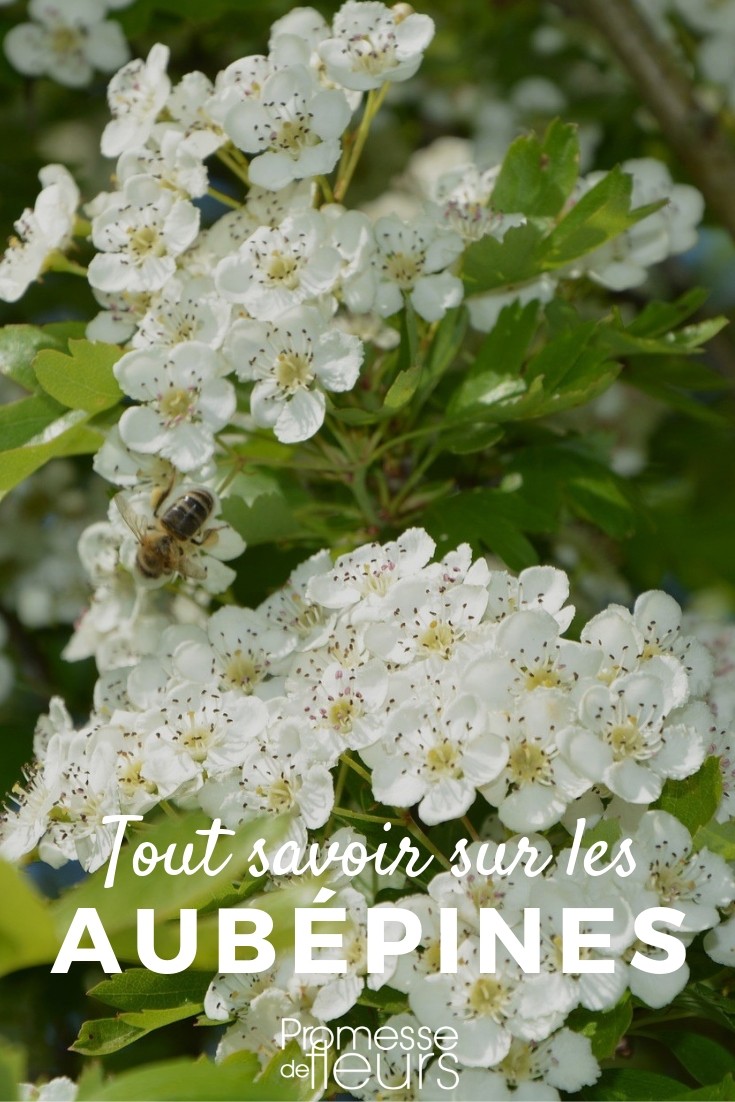


































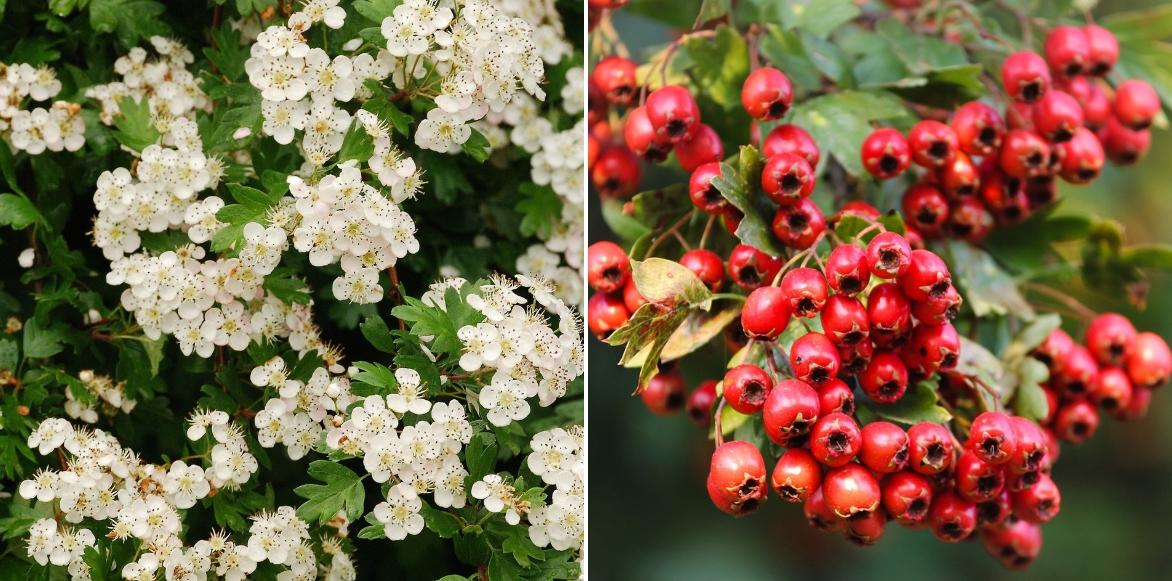
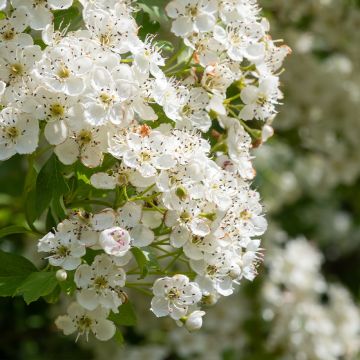
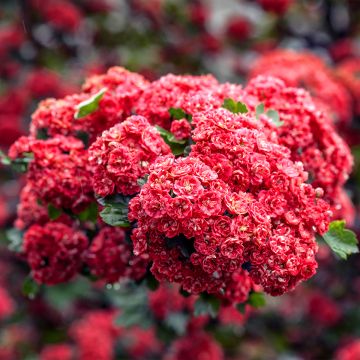

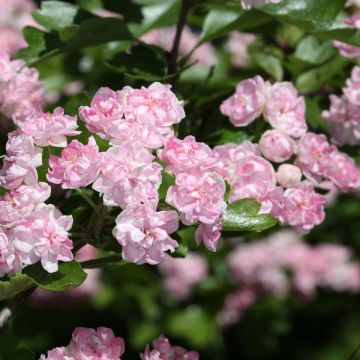

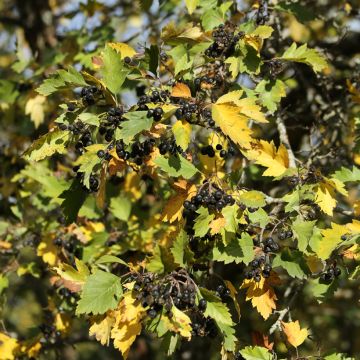
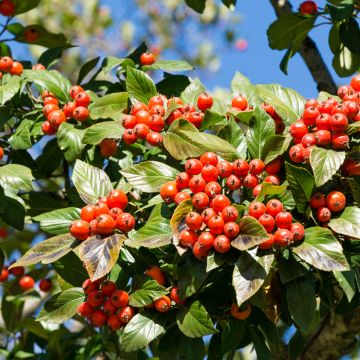
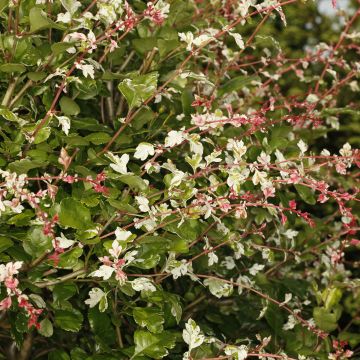
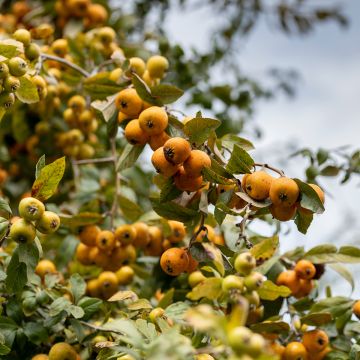
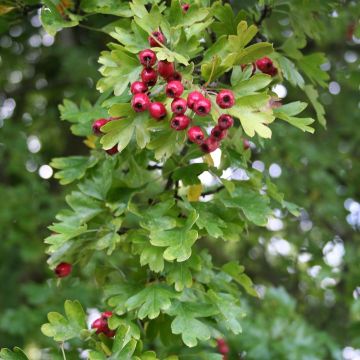

Comments